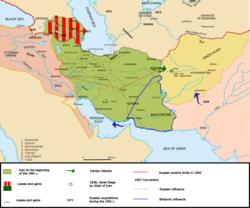
Back Kadjar-dinastie Afrikaans Kadscharen ALS القاجاريون Arabic Dinastía Kayar AST Qacarlar sülaləsi Azerbaijani قاجار خاندانی AZB Каджары Byelorussian Каджар Bulgarian কাজার রাজবংশ Bengali/Bangla Dinastia Qajar Catalan
Kerajaan Mulia Persia دولت علیّه ایران Dowlat-e Elliye-ye Irân | |||||||||||||||
|---|---|---|---|---|---|---|---|---|---|---|---|---|---|---|---|
| 1785–1925 | |||||||||||||||
| |||||||||||||||
| Lagu kebangsaan: ' 'Salâmati-ye Shâh | |||||||||||||||
 Peta Parsi dibawah Wangsa Qajar. | |||||||||||||||
| Ibu negara | Tehran | ||||||||||||||
| Bahasa yang umum digunakan | Parsi (bahasa rasmi),[1][2] | ||||||||||||||
| Kerajaan | Monarki mutlak (1785–1906) Monarki perlembagaan | ||||||||||||||
| Shah, Mirza | |||||||||||||||
• 1794–1797 | Mohammad Khan Qajar | ||||||||||||||
• 1909–1925 | Ahmad Shah Qajar | ||||||||||||||
| Perdana Menteri | |||||||||||||||
• 1906 | Mirza Nasrullah Khan | ||||||||||||||
• 1923–1925 | Reza Pahlavi | ||||||||||||||
| Sejarah | |||||||||||||||
• Penubuhan | 1785 | ||||||||||||||
• Wangsa Pahlavi | 1925 | ||||||||||||||
| Mata wang | Toman | ||||||||||||||
| |||||||||||||||
Paparan amaran: Page using Template:Infobox country with unknown parameter "region"
Paparan amaran: Page using Template:Infobox country with unknown parameter "continent"
Paparan amaran: Page using Template:Infobox country with unknown parameter "country"

Wangsa Qajar (Bahasa Parsi: سلسله قاجاریه atau دودمان قاجار - Qâjâr) adalah dinasti Parsi yang memerintah Iran dari 1781 hingga 1925. Kerajaan ini diasaskan pada tahun 1781 oleh Agha Muhammad Khan yang merupakan ketua suku Qajar Qoyunlu dari Azerbaijan moden hasil penumpasan raja Lotf Ali Khan, penguasa terakhir dalam Dinasti Zand.
- ^ Homa Katouzian, "State and Society in Iran: The Eclipse of the Qajars and the Emergence of the Pahlavis", Published by I.B.Tauris, 2006. pg 327: "In post-Islamic times, the mother-tongue of Iran's rulers was often Turkic, but Persian was almost invariably the cultural and administrative language"
- ^ Homa Katouzian, "Iranian history and politics", Published by Routledge, 2003. pg 128: "Indeed, since the formation of the Ghaznavids state in the tenth century until the fall of Qajars at the beginning of the twentieth century, most parts of the Iranian cultural regions were ruled by Turkic-speaking dynasties most of the time. At the same time, the official language was Persian, the court literature was in Persian, and most of the chancellors, ministers, and mandarins were Persian speakers of the highest learning and ability"

